DAY 6, August 1, 2012:
Catherine Palace & Gardens, Pushkin:
From Vostaniya , took the metro to
Vietbsky at 8 AM, walked over to the Vokzal, went up 1st floor and
right up to platform and bought return tickets for the suburban train
and got into the one standing right there, ... must say it was a
little tough to find the ticket counter as we had to cross over many
halls and go right up to the platform
Guess this is to be expected as all
these vokzals have long distance trains going even to different
countries--so tracing a suburban section is a little difficult...
Reached Destskoe Selo vokzal in 30 min,
took a marshrutka and landed at the palace grounds before 9am.
A lady who was working at the palace
guided us to get down at the correct stop as she heard us enquiring
the driver where to get down.. we were asking "ekaterininisky
(catherine's) dvorets (palace)...sledushya(next) stansiya (station)?"
As usual, we were the only ones on the
palace grounds and enjoyed the ambience.
This regular part of the Catherine Park
occupies the area between the Catherine Palace, the Cascade Ponds and
the Great Pond. The central alley of the Old Garden –
On this terrace that runs parallel to
the façade of the Catherine Palace note the patterned parterre that
resembles the parquet floors inside the palace.
There are special admission hours for
independent travelers in Pushkin from 12:00 to 14:00 and from 16:00
to 17:00...our plan had been to buy the palace tickets for a visit at
12 noon or 4 PM when the ticket counter opened at 9.30 and then go to
Pavlosk to see the palace and gardens there before returning here....
However, the authorities were letting
in the guided groups at 9AM and were going to sell tickets for
individuals only at 12.
We had to wait in queue for over 2
hours to get the ticket and simultaneously get in instead of getting
the ticket in advance and using our time better....oh well, we rolled
with the punch....
The town's original name, Tsarskoye
Tselo (Tsar's Village), comes from the palaces and parks built by
Empresses Catherine I (Peter the Great's second wife) and Elizabeth I
(their daughter). Catherine's Palace (Yekaterinsky Dvorets) is the
world's longest palace, at 300m (984 ft.)
In the Soviet era, the town was named
after Russian poet Alexander Pushkin, who studied here for 6 years in
the early 19th century and later had a dacha (country house) in town.
The town has since readopted its pre-revolutionary name, but many
Russians still refer to it as Pushkin.
We had to be part of a guided tour in
Russian. We however, looked around on our own
Cavaliers’ Dining-Room:
The first room beyond the Great Hall is
the Cavaliers’ Dining-Room. It is not particularly large and so
the architect placed mirrors and false windows containing mirrors on
the walls, making the hall spacious and bright.
The Cavaliers’
Dining-Room is adorned by a multi-tiered tiled stove with cobalt
painting, columns and niches. Heating stoves like this are an
inseparable part of all the state rooms in the main suite of the
palace.
A couple of net pics here...
A couple of net pics here...
The treatment of the interior is
typical of the Baroque, dominated by carved and gilded ornament of
stylized flowers and seashells. The gilded dessus-de-porte –
over-door – compositions are particularly magnificent....
The Great Ballroom:
.
These video grabs are grainy because our camera video setting was inadvertently at low res...
Models in imperial costumes were
available for photos...here are some online pics of the Ballroom with no crowd...
There is a rule that guided groups can
visit St Petersburg without a Russian visa and all cruises take
advantage of this
Several cruise ships dock at st
petersburg and guides take groups to all the attractions
Even other tourists pay 100$ to the
guides to be part of gruops as they find it difficult to negotiate
trips on their own. Result---we see lots and lots of groups
rushing behind guides holding a flag on a stick--quite a funny sight
in all tourist spots.Independent tourists like us are few
and far between
Green pilaster room:
This is the Green pilaster room.
To
create a different look, the architect used colored metal foils on
the wall, then covered them with glass and framed them in gold.
Red pilaster room:
Elizabeth had 13000 ball
costumes--never repeated a party dress... this is Catherine the great
AMBER ROOM:
The amazing amber room...
In November
1716 after an alliance, Prussian king William I gave Peter the Great
gifts that included the Amber Study.
His daughter, Empress Elizabeth, found a use for the precious gift from Berlin in the new residence that was being built for her – the third Winter Palace in 1743.
His daughter, Empress Elizabeth, found a use for the precious gift from Berlin in the new residence that was being built for her – the third Winter Palace in 1743.
In July 1755 Elizabeth ordered to
create a new Amber Room in the Great Palace at Tsarskoye Selo (the
Catherine Palace) but since there were not enough panels, lower walls
were painted to look like amber.
In 1763 Empress Catherine II got the
painted canvas replaced with newly-made amber panels.
During Nazi invasion in June 1941, the
evacuation of museum treasures from the Catherine Palace began. ...
paper was pasted over the panels, then gauze, then cotton wool and
wooden boards.
German specialists for plundering works
of art spotted and removed the amber panels and dispatched to
Königsberg... trail of original amber study ends here... the panels
here are recent replacements
Adjoining the Picture Hall is the Small
White Dining-Room (1752)which was the first room in the personal
apartments of Empress Elizabeth and after her of Catherine II, who in
her turn passed them over to her favorite grandson, the future
Emperor Alexander I.
The walls are lined with white damask
in carved and gilded frames; The interior also features a stove with
“Hamburg” tiles, mirrors in carved and gilded frames and a
patterned parquet floor – traditional elements of Baroque
décor...Parquetry is a geometric mosaic of wood pieces used for
decorative effect....
Amber:
Amber is produced from a marrow
discharged by trees belonging to the pine genus, like gum from the
cherry, and resin from the ordinary pine. It is a liquid at first,
which issues forth in considerable quantities, and is gradually
hardened
Many trees produce resin, but in the
majority of cases this deposit is broken down by physical and
biological process. Exposure to sunlight, rain, and temperate
extremes tends to disintegrate resin, and the process is assisted by
microorganisms such as bacteria and fungi. For resin to survive long
enough to become amber, it must be resistant to such forces or be
produced under conditions that exclude them... takes millions of years
The classical name for amber was
electrum (ἤλεκτρον ēlektron), connected to a term for the
"beaming Sun", ἠλέκτωρ (ēlektōr). According to
the myth, when Phaëton son of Helios (the Sun) was killed, his
mourning sisters became poplars, and their tears became the origin of
elektron, amber
Waiters’ Room :
On display here today
are marquetry card-tables from the late eighteenth century, a
Swedish-made chest of drawers from the second half of that century
and mahogany chairs made by Russian craftsmen in the nineteenth
century
The walls are hung with paintings from the Tsarskoye Selo collection: a Mountain Landscape by Murillo, a View from the Palatine Hill by Pietro Labruzzi, a Waterfall at Tivoli by Andrea Locatelli and Ruins by Alexei Belsky
This is the view of the royal gardens
from the palace
The central alley of the Old Garden –
the main compositional axis of the entire palace-and-park ensemble –
connects the palace with the Hermitage pavilion.
From in front of the palace we can
clearly see the division of the area into two parts: the upper
section (in front of the Catherine Palace) with descending terraces
connected by flights of stone steps, and the lower section.
The other rooms open to visitors are lovely as well...

The other rooms open to visitors are lovely as well...

Grand staircase:
This is the grand staircase
Souvenir shop:
At the souvenir shop with the lovely Russian dolls
Took a video of the lovely amber
jewellery and craft pieces available at the shop

Malachite pieces...

Malachite pieces...
Catherine Park:
The Catherine Park is made up of two parts: the Regular Park – Old Garden – and the Landscape (English) Park. The Old or Dutch Garden was begun by Peter I himself.
Dutch master gardeners laid out the Old
Garden in the 1720s on three terraces in front of the imperial palace
The gardens have 2 parts, the old
garden and the landscape (English) park
This is the old garden with lovely
summer flowers in full bloom on a cool summer day...


The background building is the 2 storey classical style Cold Bath (1780). Its lower floor contained a bathing hall, a warm bathroom and a Russian steam bath. The upper floor consisted of six richly finished rooms for relaxation and amusements that became known as the Agate Rooms. the eighteenth-century décor of the Agate Rooms has survived .
The Urals had new deposits of jasper,
agate, cornelian and other semi precious minerals. Russian lapidary
works made articles from hard semiprecious stone and decorated
palace halls. For decorating the second storey using jasper Cameron
prepared designs for two jasper cabinets. twelve centimetres of
masonry was knocked off the walls of these small rooms; then
covered with limestone slabs and faced with jasper using the “Russian
mosaic” technique. The main difficulty was the finishing work –
grinding and polishing the coloured stone. The polishers had to give
a mirror-like sheen to around two hundred square metres of walls,
architraves and cornices. Russian craftsmen carried out this work by
hand.
has details and pics
.
THE CAMERON GALLERY:
This is THE CAMERON GALLERY
There were several newly married couples taking pics in the palace pavilions in the gardens..
The gallery that Empress Catherine II
conceived as a place for strolls and philosophical conversations is
located on the slope of a hill on the boundary between the regular
and landscape areas of the Catherine Park near the Catherine Palace.




The walls of the lower storey of the
gallery are faced with rusticated Pudost stone and pierced by arched
mullioned windows. The lower storey serves as a base for the
colonnade above, which consists of 44 white fluted columns with Ionic
capitals.
The large windows of the glazed
hall in the central part of the upper storey make it completely
transparent. The juxtaposing of the mighty arcade of the lower storey
and the light upper one determines the aesthetic impression created
by the Cameron Gallery and embodies the philosophical idea of the
eternal contrast of existence.
Again a cloudy day but rain held off at Pushkin...Mirror Pond on the third terrace and on the stream called Vangaza flows down the hill where there are two more ponds: the Upper (Great) Pond and the Mill Pond ( Cascade or Lower Ponds).
The red buildings in the background is complex of three pavilions known as the Admiralty on the bank of the Great Pond in the Landscape Park (the Catherine Park)
Another newly wed couple in the background near the lake...
The lower floor of the central block
was used for the storage of the boats on which courtiers took trips
on the Great Pond. In the nineteenth century it contained a
collection of rowing vessels from different countries of the world,
including Catherine II’s barges
The towers of the central block contain
staircases leading to a large, bright hall in the second storey.
During Catherine II’s boat trips on
the lake an orchestra would play here.
Flanking the central pavilion are two
blocks known as the Birdhouses or Aviaries. Various kinds of water
birds (ducks and swans) used to be kept in them, as well as pheasants
and peafowl. The main building and two wings are linked by a railing
The architectural complex of the
Admiralty also included the Sailors’ House, located to the right of
one of the Birdhouses. This was the living quarters of the oarsmen
who in the eighteenth century provided boat trips and ferried people
across to the island in the Great Pond.
At present the central block of the
Admiralty complex is used for temporary exhibitions, while a
restaurant named The Admiralty works in one of the Birdhouses
Cameron treated the monumental steps
with brilliant simplicity and embellished its buttresses with two
colossal statues – of Hercules and Flora – cast in bronze.
Lower bathhouse intended for use by
courtiers (1778)-- it has 10 rooms around a central hall with a large
round tub. renovated in 2011, this pavilion has an exposition-- can
see the people visiting it....
Bodies of water occupy a fifth of the
area of the Catherine palace gardens
.
The natural slope of the terrain
towards the north-east has made it possible to link all the bodies of
water into a single gravity-driven system .
Morea (or Small Rostral) Column:
The Morea (or Small Rostral) Column
seen here was set up at the junction of three alleys in the regular
part of the Catherine Park, by the cascade between the first and
second Lower Ponds as a monument to successes in the Russo-Turkish
Wars. The column was erected in 1771, on the orders of Empress
Catherine II,
The relatively short (7-metre) column
is impressive from a distance. Its pedestal stands on a square plinth
raised slightly above the ground. The material for the pedestal and
the shaft of the column is grey Siberian marble with white veins,
while white Carrara marble was used for the capital and base. The
column is topped with a small cone-shaped obelisk of pink Tivdiya
marble embellished with the stylized prows of ships (rostra in Latin)
as a reminder that the victory involved the navy.....
Ducks have a field day being fed by the
visitors. Statues abound...
Milkmaid fountain:
The Milkmaid fountain widely known as the Tsarskoye Selo Statue or The Girl with a Pitcher occupies a special place among the park sculpture
A granite rock serves as a pedestal for
the bronze sculpture of a girl. A jet of spring water flows from the
broken pitcher lying at her feet to collect in the adjoining basin.
Originally this basin was made in the form of a grotto entered by
steps of Pudost stone. The grotto only existed until the middle of
the nineteenth century.
At the outbreak of war, before German
units reached the town of Pushkin, the statue of the Milkmaid was
buried in the ground and so was not damaged. Today the bronze
original of The Girl with a Pitcher is kept in the stores of the
museum-preserve (the sculptor’s plaster model is in the State
Russian Museum) and a copy, cast in 1990, has been set up in the
park.
These gardens had just one
fountain--after seeing complex stuff at Peterhof the previous day,
this was a different flavor...enjoyable in its own way.
This is sculpture in honor of Russian
naval victories
Turkish Bath:
The “Turkish Bath” pavilion was
erected on a small headland in the south-west part of the Great Pond
between 1850 and 1852 on the orders of Emperor Nicholas I. It was the
last structure to be built on the territory of the Catherine Park.
This pavilion, devised as a memorial
to the Russo-Turkish War of 1828–29, is designed like a Turkish
mosque. The dome of the building is decorated with relief ornament,
while the tall minaret crowned by a spire and crescent give it a
picturesque appearance
has pics of interior
The Chesme Column erected in 1774–78
to celebrate Russian naval victories in the war against Turkey is in
the background to our left
There were a few pavilions open for
visitors--We did not visit any though for paucity of time
Pyramid:
This is the Pyramid – one of the first
pavilions in the Landscape Park (the Catherine Park) – was
constructed in 1770–72 .
The Pyramid was deliberately placed
aside from the main path, so that strollers lulled by the quiet of
the shady park might come upon it unexpectedly
The Pyramid is made of brick and faced
with trimmed granite. One side is pierced by the entrance. The
room inside the pavilion is covered by a hemispherical vault with an
opening in the centre. The walls contain niches for the storage of
urns.
Behind the Pyramid, opposite the
entrance, three of Catherine II’s favourite dogs were buried: Tom
Anderson, Zemira and Duchesse.
After the visit to the palace, took off
the plastic shoe covers in this room.
They had a lovely restroom --charging
25 rubles (less than a dollar) for use. We were grateful after the
previous day Peterhof experience
Pavlosk Palace:
From Pushkin, boarded a bus to Pavlosk.
An old man asked gruffly where we were going--thinking we are taking
the wrong direction while meaning to return to Pushkin train station.
We were touched he was looking out for
us. Another lady guided us where to get off for the Pavlosk palace...
she made us get down at the garden entrance though and we reached the
palace after a long trek of 2 miles thru wild woods in a steady
drizzle...these are some nice pics found online showing the lovely English garden we trudged through in drizzle...
We were wet and cold when we arrived at the palace...but the beauty and poignant story of the royals made us forget our niggles...
We were wet and cold when we arrived at the palace...but the beauty and poignant story of the royals made us forget our niggles...









2 palaces and 2 royal gardens in one
day...sure was hectic and awesome...again by a stroke of goodluck, a
workman asked us where we were going when we were retracing our 2
mile trek back to the entrance. we said avtoboos... he said it is
available near by at the gate just 100m away.... we gladly boarded
the bus and reached Catherine's Palace stop. From there took another
bus to the train station.
End of an Awesome day!
The next day was equally, if not more, FABULOUS with a visit to Hermitage:
http://adventuretrav.blogspot.com/2016/12/russia-trip-report-day-7-hermitage.html
End of an Awesome day!
The next day was equally, if not more, FABULOUS with a visit to Hermitage:
http://adventuretrav.blogspot.com/2016/12/russia-trip-report-day-7-hermitage.html







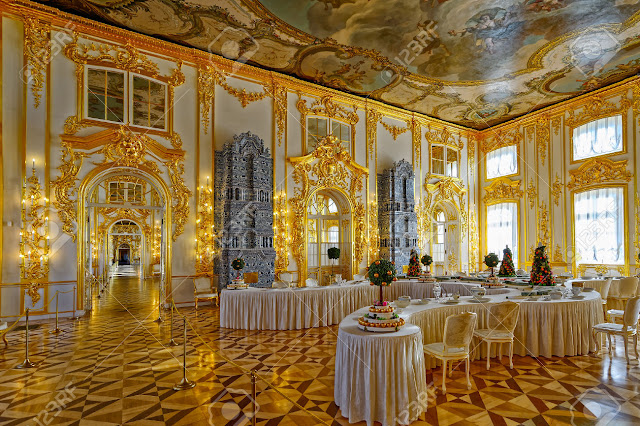


























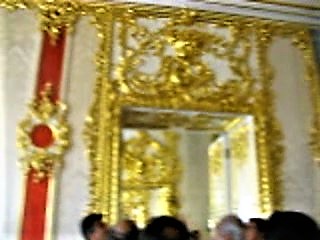

























































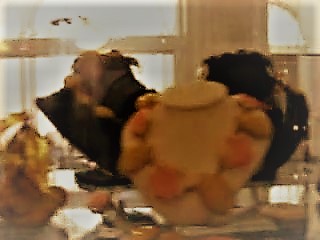














































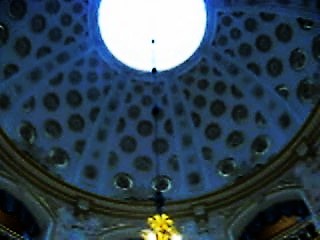












































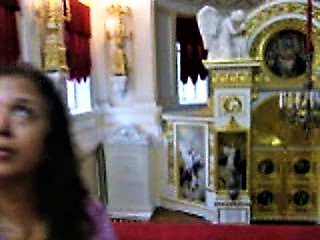





No comments:
Post a Comment